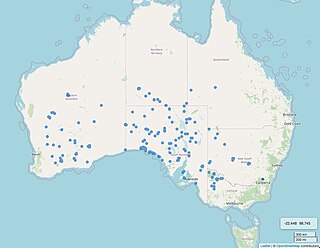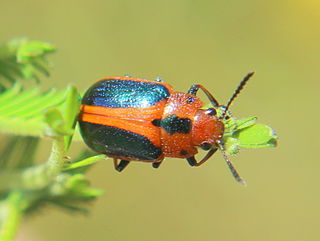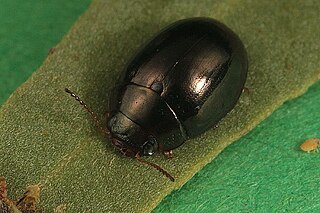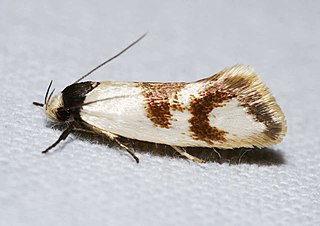
Arthur Mills Lea was an Australian entomologist.

Kippistia is a genus of flowering plants in the family Asteraceae. The name commemorates Richard Kippist, librarian to the Linnean Society.

Meridolum middenense is a species of air-breathing land snail, a terrestrial pulmonate gastropod mollusk in the family Camaenidae. This species is endemic to Australia.

Harmonia testudinaria, commonly known as the tortoise-shelled ladybird, is a species of ladybird belonging to the family Coccinellidae. The tortoise shelled-ladybird occurs in Australia, New Guinea, Indonesia and Hawaii.

Eupoecila evanescens, commonly known as the orange spot beetle is a member of the scarab beetle family from north-eastern Australia, belonging to genus Eupoecila.

Eupoecila inscripta is a species of scarab beetle in the genus Eupoecila, found in western Australia.
Eupoecila miskini is a member of the scarab beetle family indigenous to Australia, belonging to genus Eupoecila. It is closely related to Eupoecila inscripta.

Calomela is a genus of beetles commonly called leaf beetles and in the family Chrysomelidae. They are specialist feeders on various species of Acacia and are not reported as a problem species. The beetles are cylindrical when compared with other leaf beetles and their larvae are globose. Calomela includes about 45 species which are found in all states of Australia.

Geomela is a genus containing several small dark beetles in the family Chrysomelidae . They are flat when compared with other leaf beetles. There are 13 species which occur mainly in the southeastern parts of Australia.

Chalcolampra is a genus of leaf beetles. These beetles are widespread from Southeast Asia to Australia and New Zealand, but most common in the southeast of Australia. There are approximately 25 Australian species within this genus. There are also 13 species described from New Zealand, with up to an additional 20 undescribed species from the South Island.

Lamprolina is an Australian genus of leaf beetles (Chrysomelidae) found in Victoria, New South Wales, and Queensland.

Lamprolina aeneipennis is an Australian beetle species in the family of leaf beetles (Chrysomelidae), which is found in eastern Australia, in Queensland, New South Wales and Victoria, but in New South Wales only. It was first described in 1835 by Boisduval as Phyllocharis aeneipennis.

Antipterna trilicella is a species of moth in the family Oecophoridae, first described by Edward Meyrick in 1885 as Ocystola trilicella. It appears to be a moth endemic to Australia and confined to the east coast, occurring in Victoria, New South Wales and Queensland.

Antipterna euanthes is a species of moth in the family Oecophoridae, first described by Edward Meyrick in 1885 as Ocystola euanthes, with the female lectotype being found in the Wirrabara Forest, South Australia. It appears to be a moth endemic to Australia and in addition to South Australia is also found in Victoria, New South Wales, and Queensland.
Antipterna acrobaphes is a species of moth in the family Oecophoridae, first described by Edward Meyrick in 1885 as Ocystola acrobaphes. The holotype was collected in Sydney, New South Wales, in January 1878.
Cadmus colossus, or Cadmus (Brachycaulus) colossus, is a species of beetle in the subfamily, Cryptocephalinae, or case-bearing leaf beetles, and the subgenus, Brachycaulus. It was first described by Félicien Chapuis in 1875, from a male specimen collected at Port Denison. It is native to Australia, being found in New South Wales and Queensland.
Austrochernes is a genus of pseudoscorpions in the subfamily Chernetinae, first described by Max Beier in 1932. Species of this genus are found in mainland Australia and New Guinea. The Australian Faunal Directory decisions for synonymy are based on a 2018 paper by Mark Harvey.

Peltoschema nigroconspersa is a species of beetle in the leaf beetle family (Chrysomelidae). It was first described in 1865 as Paropsis nigroconspersa by Hamlet Clark.

Theclinesthes onycha, the cycad blue is a small butterfly found in Eastern Australia, coastal and inland from Cape York Peninsula to the southern-most part of New South Wales.
Chalcomela is a genus of beetle in the family Chrysomelidae. It is found in Australia and New Guinea.
















